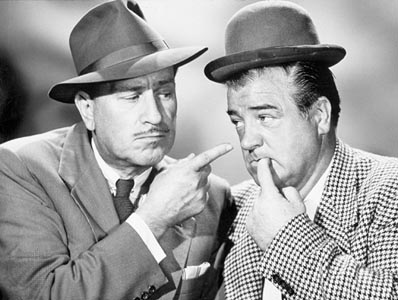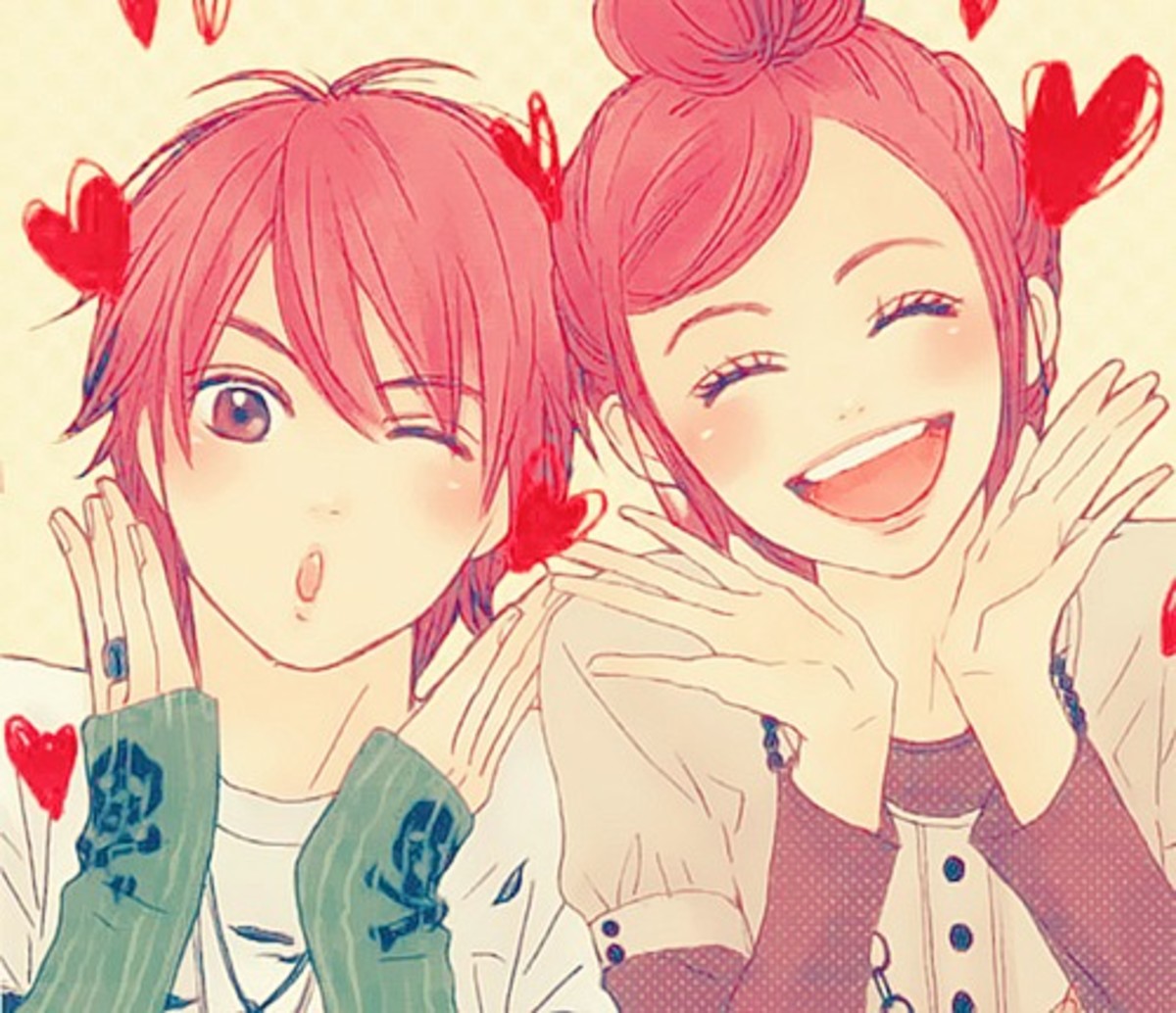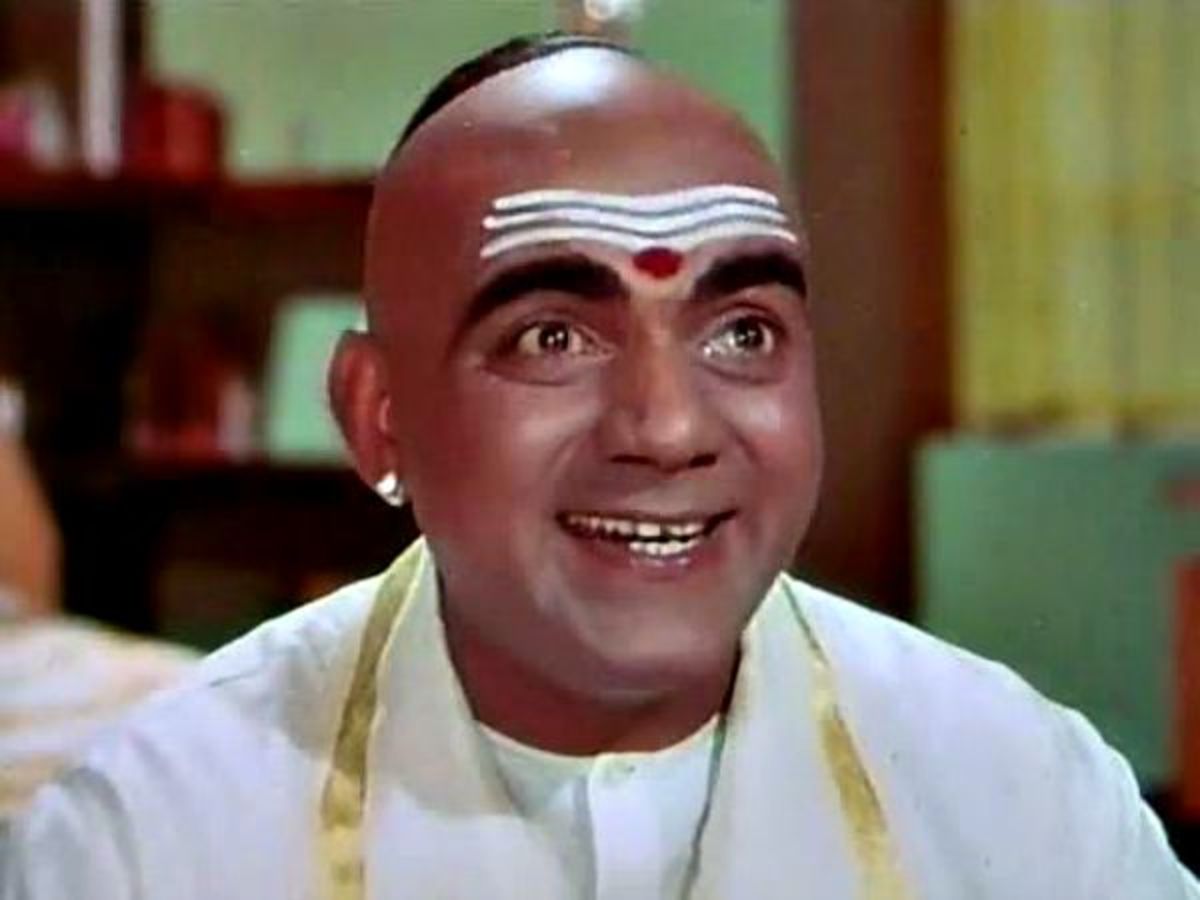Bud Abbott and Lou Costello: Kings of Comedy
Bud Abbott (Left) and Lou Costello

The Bud and Lou Story
In the days of the classic comedy teams in the Golden Age of Hollywood, the most popular and prolific was the team of Bud Abbott and Lou Costello. Their 20 year partnership spanned the entertainment spectrum from stage to radio to film and to television. They made 36 movies together (More than any other comedy team) and were the biggest comedy stars of the 1940s.
Pre-Partnership:
William “Bud” Abbott was born in Asbury ParkNew Jersey, USA, in 1895. He was from a show business family. His parents were circus people. Bud quit school at 16 and began performing in New York’s Coney Island. He married Betty Smith (A comedian and dancer) and they formed a traveling comedy troupe in 1918.
Bud soon realized he didn’t have the gregarious charisma that it takes to be a comic lead performer so he focused on being the “straight man”. (The straight man is the half of a comedy team who feeds the unfunny set-up lines to the “goof” or funnyman, and the goof gets all the laughs.) Bud worked with several “goof” partners, including Betty, hoping to find the perfect partner. It took a while, but he finally found his comic counterpart in 1935.
Louis Francis Cristillo—AKA Lou Costello—was born in PatersonNJ in 1906. He was a gifted High School athlete, particularly in boxing. He left High School to pursue a boxing career under the name King Louie. When the boxing didn’t pan out, Lou was encouraged to try his hand at performing. Everyone who knew him felt he was a natural comedian. Lou moved to Hollywood but had trouble getting roles. He worked for a while as a stunt man and an extra. After he ran out of money, he tried to hitchhike his way back to NJ but got stalled in Missouri. Broke and hungry, he took a job working in a Burlesque theater. Changing his name to Costello, he soon managed to convince the theater owner to let him perform. Lou became a regular performer and married a dancer named Betty Baxter.
When Bud met Lou:
Bud Abbot’s traveling comedy troupe played an engagement in the Missouri theater where Lou Costello was performing in 1935. Bud was still searching for his ideal partner and when he saw Lou perform, he knew his long search was finally over.
Bud saw the comic potential in Lou instantly. Lou had great energy and brilliant comic timing. Bud felt that the only thing Lou was missing was a good straight man. He approached Lou and invited him to lunch to talk business. No one knew at the time what this lunch meeting lead to.
Bud pitched a partnership offer to Lou. Lou didn’t really feel he needed a straight man but he liked Abbott’s offer to travel with the troupe as the lead comedy act. It would bring a lot of attention to him. It was far better than performing in a small Missouri theater. Lou agreed to the partnership, although the deal almost fell apart immediately over the issue of billing. Lou didn’t like Bud’s proposed team name Abbott and Costello. Lou wanted first billing. However, Bud pointed out that it was a long established tradition that the straight man gets first billing. Lou finally agreed and the legendary team of Abbott and Costello was born.
The Partnership:
The team spent the next few years traveling the Burlesque circuit. Despite the reputation of Burlesque for using strippers and off-color comedians to draw patrons, Abbott and Costello refused to participate in such things. Their comedy remained clean and would stay clean for their entire careers.
The teaming of the duo finally paid off in 1937. As the troupe toured, the reputation of the featured comedy team grew. They soon became highly in demand, not only in burlesque but in Vaudeville as well. Their reputation preceded them and they started to get feature billing wherever they went.
A big part of their success was due to a friend of Bud’s named John Grant, a popular comedy writer. Grant re-wrote many old standard stage comedy routines to better suit Bud and Lou’s personality. Grant’s routines are part of Bud and Lou’s legend. The routines include “Mustard is made for the Hot Dog”, “Electricity is a Watt”; “Floogle Street”; “Heard of Cows”; “7 x 13=28”; “The Lemon Table”; “Niagara Falls (Slowly I turn)“; “You’re 40 and she’s 10”; “Jonah and the Whale”; “Packing/Unpacking”; “Loan me $50”; “The Army Drill” ; “The Moving Candle”; “Go Ahead and Order Something”; “Alexander 4444”; “The Piano” bit; “Making Money Loafing”; “Go Ahead and Back Up”; Limburger Cheese”; “Mudder/Fodder”; and others, including the unforgettable, unequaled “Who’s On First?”
Their big break came in 1938 when they were invited to appear for 10 weeks at the exalted Pantages Theater, the most popular theater in the Vaudeville circuit. Headlining the Pantages was the biggest honor in vaudeville. Talent scouts often visited the Pantages looking for good acts to sign. Many stars got their lucky break at the Pantages. Also, the Pantages paid far better than anywhere else the duo had ever appeared.
But there was an issue between Bud and Lou. They were at odds because appearing at the Pantages would mean leaving the touring group and breaking the steady chain of engagements Bud had cultivated. The theater owners of the venues where Bud and Lou were scheduled to perform would be irate if the duo abruptly cancelled to appear somewhere else. Bud worried that if the duo did not get signed up by someone after their stint at the Pantages, they would end up unemployable because they would have earned the ire of the theater managers they relied on for continued touring appearances. Lou, on the other hand, wanted bigger things from life than touring the vaudeville circuit for the rest of his life. He wanted to roll the dice and gamble that their 10 weeks at the Pantages would be the springboard to fame. Lou was confident in his talent and knew that if he got the right showcase, he’d make it to the big time.
The duo argued until Lou basically bribed Abbott by offering him a 60/40 % split of the profits (Bud would get the 60%) at the Pantages. Bud’s wife Betty encouraged Bud to take the risk. Bud finally agreed but the 60/40 split was a sore spot for Lou and would later come back to haunt Abbott.
The gamble paid off. As Lou predicted, their 10 week engagement at the Pantages was so successful that they were discovered by an agent who arranged for them to appear regularly on the popular Kate Smith Radio Show. Their year as supporting players on Kate Smith’s show made them popular coast-to-coast. Their routines began to enter the public consciousness. Lou’s trademark catchphrase “Hey Abbott!” was repeated all over America. (Lou started using a more high-pitched, child-like voice during this period to better differentiate him over the radio from Abbott.)
In 1939, Abbott and Costello were given their own weekly Radio show. It was an instant hit. Their program was the most popular program on radio, which was the equivalent today of having the number one TV show. Kids everywhere were shouting Lou’s other catchphrase, "I'm a Bad Boy!". The pair became household names.
In 1940, they appeared in their first film, One Night in the Tropics. Although they were merely supporting players, they stole the film away from top billed actors Bob Cummings and Alan Jones. They even did an abridged version of their most popular routine “Who’s on First?” It was obvious that they had what it takes to be movie stars.
Universal Studios signed Abbott and Costello to a long term contract. Starting in 1941, the studio rolled out a trilogy of service comedies for the duo (Buck Privates, In the Navy, and Keep ‘em Flying) followed by a haunted house comedy called Hold That Ghost and then a Western Parody Ride ‘em Cowboy. All of them were very successful. The team shot to stardom and became the most popular comedy team of the early forties.
The team kept going strong over the next few years and made 10 more films by 1946. It seemed that there was no stopping the comedy juggernaut. But personal differences almost ended their run at the height of the pair’s popularity.
Bud and Lou hadn’t been getting along since their movie careers started. Lou was a very competitive person with a desire to prove himself as the king of comedy. He resented his status as part of a team. He hated listening to interviews where Bud discussed how important the straight man was to the team. Lou never felt that he needed a straight man and often said publicly that he could be just as funny without Abbott. Abbott, although generally good natured, got angry when Costello made light of Bud’s importance to the Act.
Lou, who never forgot a slight or a wrong, never got over the 60/40 split at the Pantages. Since Lou had been proven right and the gamble had paid off, he nursed a grudge that Bud had taken the lion’s share of an engagement that Bud hadn’t wanted to do. As a result of this, and of Lou’s belief that he didn’t really need Abbott, Lou insisted on a 60/40 split for future profits (With Lou getting the 60%) and a name change to Costello and Abbott.
Universal Studios intervened. They would not allow the team to change the name of the act. They gave Lou a raise so that he was making more than Abbott but not a 60/40 split. Neither member of the team was happy with the result. Lou didn’t get the name change and Bud was now getting paid less than his partner.
The straw that almost broke the team’s back was when Abbott hired a domestic servant who Lou had fired. (Lou accused her of stealing.) Bud immediately gave her a job when he heard. Was it an act of charity or did he do it to annoy Lou? Who knows! Whatever the reason, Lou announced that he no longer wanted to work with Abbott.
Universal had other ideas, however. They still had Bud and Lou under contract and they intended to hold their comic cash cows to the full length of the agreement. Bud and Lou were forced to work together but they made arrangements with the studio to limit the amount of screen time they had together.
Their next two films were unusual, because Bud and Lou had very few scenes together. The two films they made in 1946 were of very differing quality. Little Giant was one of their weakest, least funny films, while the follow-up The Time of Their Lives is a fan favorite. Both were atypical of the team.
Bud and Lou still refused to speak off-camera until the following year when Lou’s young son Louis Jr. tragically drown in the Costello’s swimming pool. Lou was devastated and Bud forgot about any grudges and he was there to support his partner during this horrible period. It was Bud’s idea to name the children’s hospital wing that the pair had financed after Lou Junior. Lou was very touched. This led to a reconciliation between the two.
The studio was glad to have their two top stars back on the same page. The pair was back together. They made three films in 1947, and in 1948 they made their most beloved and arguably best film, Abbott and Costello Meet Frankenstein. It was the most profitable of their career. (Lou hated the script and thought the film would be terrible. No one was more stunned by the commercial and critical success of the film than Lou was.)
However, A&C Meet Frankenstein proved to be the peak of their career and it was downhill from there. By 1950, Bud and Lou’s star was beginning to fade. They still had some screen clout but they were no longer dominating the box office as they had only a few years earlier. Lou and Bud saw the writing on the wall and decided that it was time to try a new medium. They made arrangements with the studio to appear on the new but growing medium of television.
Bud and Lou appeared as semi-regular hosts of The Colgate Comedy Hour (They alternated with other comedians, including Bob Hope.) This brought the aging stars to the attention of a new generation of viewers.
Lou felt TV was the future and started his own production company to create his own TV show. Originally, he was going to do it solo, without Abbott, but he was advised against it by his brother Pat, who was always his most trusted advisor. Pat wisely thought that Lou shouldn’t venture into an unfamiliar medium while simultaneously creating a new act. Lou agreed to hire Abbott to work on the show, but Lou was the producer and boss behind the scenes.
Although they were still under contract to Universal, the studio allowed Lou to run his own show as long as the team lived up to their movie commitments. At the same time the duo was filming Jack and the Beanstalk for Universal, they were also filming episodes for their new TV project, The Abbott and Costello Show. The format of the show resembled their old radio show and it featured many of Bud and Lou’s old classic routines. (The plots were stapled together random scenes, making it a show about nothing. Jerry Seinfeld, an admitted Abbott and Costello fan, copied this idea for his own series years later.)
The show debuted in 1951 and the first year was a ratings success. However, Lou got nervous about the some of the critical reactions to the show, saying the aimlessness of the plots could become tiresome very quickly. Lou made the erroneous decision to change the format of the show in year two, to make it more linear and traditional. Also, Pat had the bad idea to replace head writer Sid Field (who was also a regular cast member on the show) with a more conventional writer. The second season of the show was far less entertaining. Rating went down and the critics were less than kind. Lou abruptly decided to stop production of the show and focus on films instead.
But by the mid 50s, Abbott and Costello were in a slump regarding their movie careers. They’d appeared in several uninspired, mediocre films (Abbott and Costello Go to Mars, Abbott and Costello Meet Doctor Jekyll and Mister Hyde, and Abbott and Costello Meet the Keystone Cops.) The team actually wanted to call it quits but there were financial considerations. Some bad bookkeeping and some bad investments had left them both deeply in dept, and the IRS was knocking at their door for back taxes which their accountant hadn’t paid.
In 1955, the team’s contract was up at Universal and the studio no longer felt that the diminishing returns they were getting from the duo’s films merited the high salaries Universal was paying them. Universal dropped their once biggest asset from their ranks.
Still desperately in need of money, Bud and Lou made an independent film Dance With Me Henry (1956) which flopped badly, mostly because Costello wanted to play a more mature character, instead of his usual goof role. It would end up being their last film.
Unable to find funding for another film and with no studio willing to meet their price, Bud and Lu returned to stage, touring the country doing their old routines. They were fading icons of a bygone age.
The personal disputes resurfaced. Lou still wanted more money than Bud and was insisting that he get first billing. Also, Abbott had developed a drinking problem, which made him unreliable for live performances. Lou got fed up with Bud and in 1956, Lou decided to go solo.
Post Partnership;
Lou managed to get the funding together for an independent solo project called The 30 Foot Bride of Candy Rock (1957) where he played against type as a scientist who enlarges his wife due to a botched experiment. The film was a box office bomb and it ended Lou’s solo career.
Lou had numerous plans regarding what he wanted to do next but health problems prevented him from realizing his dreams of a solo comeback. He died of a heart attack in 1959, at age 53.
Bud tried to recapture his glory days on stage by teaming with a comedian named Candy Candido who did a Lou Costello imitation. Bud also did voiceover work for a Hanna-Barbara Abbott and Costello cartoon kids show. (Stan Irwin provided the voice for the late Lou.) But Bud’s health began to fail. He had a series of strokes and could no longer perform. He still owed money and made the desperate but regrettable decision to make a public plea while on a TV interview show, asking fans to donate money. The plea fell on deaf ears because fans couldn’t relate to the financial woes of a movie star, even a faded one. Bud’s health got worse and he was diagnosed with prostate cancer. He died in 1974 at the age of 78.
Abbott and Costello had an incredible 20 year run and left a legacy of comic gems that generations of people have enjoyed.






